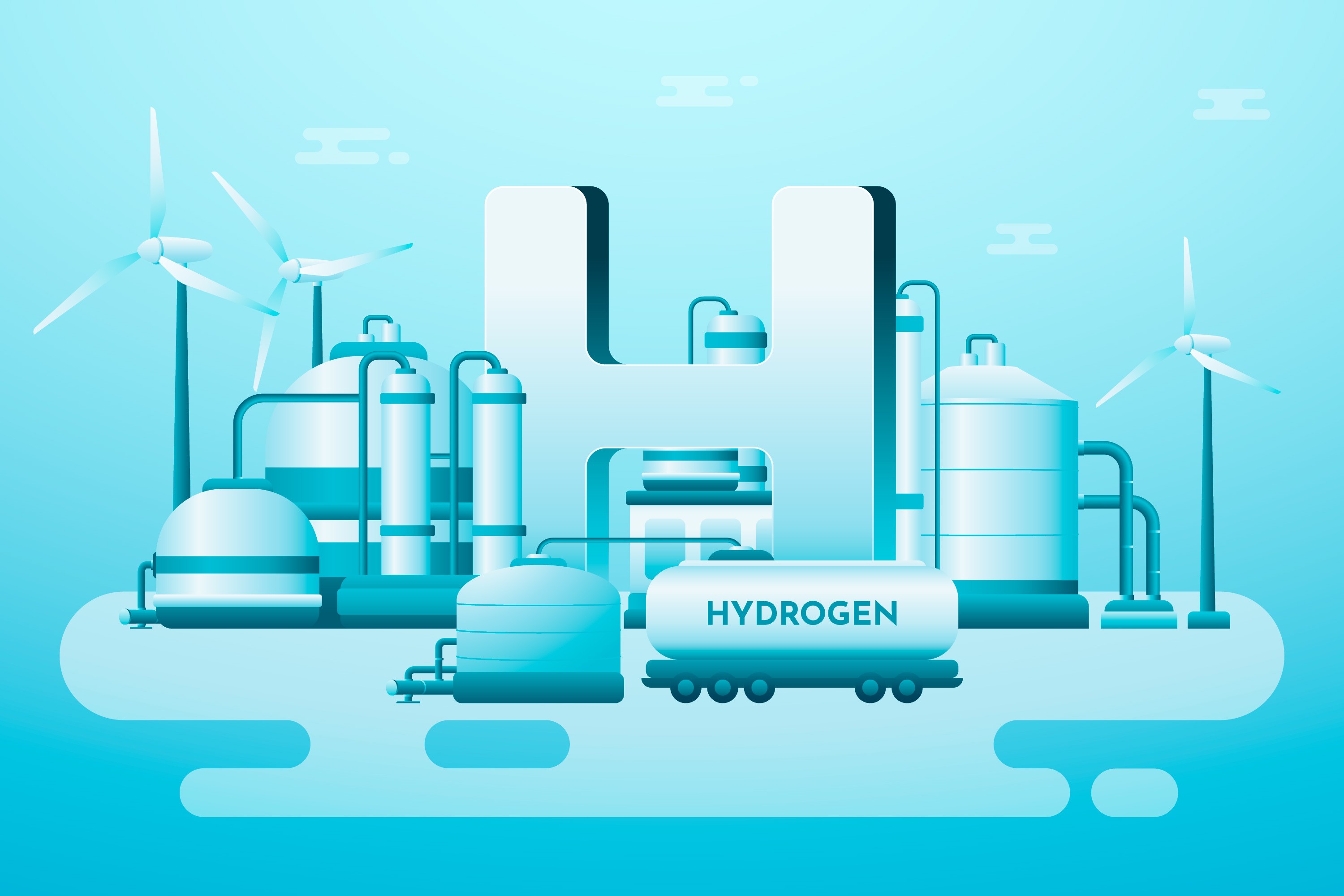An Overview
Green hydrogen, a transformative energy source produced by water electrolysis using renewable energy, offers a promising carbon-free alternative. Its applications in steel manufacturing, ammonia production, and energy storage are significant. The distinct value of green hydrogen lies in its potential to achieve net-zero emissions, with projections suggesting a 24% contribution to global energy needs by 2050, painting an optimistic picture of the future of renewable energy.
Global Market Dynamics and Projections
The global green hydrogen market is expected to grow from $5.40 billion in 2024 to $25.20 billion in 2029, with an estimated CAGR of 36.1%.
Factors driving growth include declining electrolyzer costs, rising production scales, and governmental support. Key players such as NEL Hydrogen, Siemens Energy, and ITM Power are positioned to capture significant market shares through strategic partnerships and technological leadership.
- Europe: Strong policy frameworks and technological advancements drive market growth. The region has the most advanced infrastructure, with wind energy dominating.
- Asia-Pacific: Rapid industrialization and increasing energy demand make this region a critical market. Countries like Japan and South Korea focus on green ammonia and hydrogen energy for energy security.
- North America: The region's focus on clean energy adoption, supported by technological innovations and policy incentives, contributes to a high growth rate. Investments in infrastructure and refuelling stations are critical for future growth.
Technical Advancements Driving Green Hydrogen Growth
The cost competitiveness of green hydrogen hinges on breakthrough innovations across three primary domains: electrolysis efficiency, renewable energy integration, and scaling technologies.
Electrolysis Efficiency:
- Advanced PEM Electrolyzers: Experts highlight that these are optimized for rapid response and short start-up times, making them ideal for renewable energy sources. They achieve higher purity hydrogen outputs but require costly materials like platinum, posing a challenge to cost scalability.
- Alkaline Electrolyzers: Although more robust and less expensive than PEMs, alkaline systems struggle with scalability in dynamic environments. However, new catalysts are being tested to improve output without compromising cost efficiency.
- Anion Exchange Membrane (AEM) Electrolyzers: AEMs offer a promising alternative, combining the strengths of PEM and alkaline systems. They leverage lower-cost catalysts, positioning them as potential game-changers for large-scale applications, though still under active R&D.
Renewable Integration Technologies:
- Integrating wind and solar energy directly with electrolysis is pivotal. In Europe, hybrid setups combining solar PV with electrolysis have reached operational efficiencies of 80%, reducing energy losses significantly.
- Smart grid technologies and digitalized control systems manage fluctuating energy inputs, especially in off-grid applications, allowing green hydrogen plants to maintain optimal efficiency under variable conditions.
Scaling Technologies:
- Gigawatt-scale Electrolyzers: Companies are actively developing modular electrolyzer units, which can be scaled up efficiently for large production facilities. For example, NEL Hydrogen's recent advancements focus on automated manufacturing, reducing operational costs by up to 30%.
- Thermal Management Systems: Advanced cooling solutions are being integrated to manage the exothermic heat generated during electrolysis, further enhancing operational stability and cost-effectiveness.
Overcoming Green Hydrogen Market Challenges
Despite its potential, the green hydrogen market faces distinct challenges in terms of infrastructure, production costs, and supply chain dynamics.
Here's what industry experts suggest:
- Production Costs: According to projections, green hydrogen production costs must drop to $1-2/kg to compete with grey hydrogen. Experts estimate that achieving this requires scaling electrolysis plants to gigawatt levels, a process that involves significant initial investment and careful management of energy inputs and outputs. Advancements in PEM and AEM technologies are also crucial in this cost reduction process.
- Infrastructure and Storage: The need for more mature infrastructure for storage and transportation is a significant barrier. For instance, liquid hydrogen pipelines require cryogenic insulation, making them cost-intensive. However, innovations in metal hydride storage systems and ammonia synthesis for indirect transport are seen as viable alternatives for long-term hydrogen storage.
- Policy and Investment: Industry analysts agree that targeted subsidies and incentives can accelerate adoption. For example, Europe's 'Hydrogen Accelerator' initiative, which aims to fund up to 10 million tons of green hydrogen production annually by 2030, provides a significant boost to the industry. The U.S. Inflation Reduction Act also allocates substantial funds for green hydrogen infrastructure development, emphasizing long-term adoption and providing a stable investment environment.
Green Hydrogen Applications
- Steel Manufacturing: Experts suggest replacing coke with green hydrogen can reduce CO₂ emissions by 90% in the iron ore reduction. Companies like ArcelorMittal and Thyssenkrupp are actively testing hydrogen-based Direct Reduced Iron (DRI) systems with promising results.
- Ammonia Production: Green hydrogen's role in synthesizing green ammonia is crucial for agriculture. It allows the decarbonization of fertilizers, which represent a significant portion of emissions in the agricultural sector.
- Heavy Transportation: Hydrogen fuel cells are favoured for long-haul and heavy-duty trucks, buses, and trains due to their high energy density and faster refuelling times than battery electric vehicles. Companies like Hyundai and Toyota are leading efforts in this space, with hydrogen-powered trucks achieving ranges of over 600 miles on a single charge.
- Power Generation & Storage: Green hydrogen is anticipated to play a critical role in stabilizing renewable energy grids by acting as a backup power source and a long-duration energy storage solution. This is essential for addressing variability in renewable energy supply and enhancing grid reliability. Hydrogen turbines and stationary fuel cells are projected to become more competitive, supporting peak and backup power requirements.
- Aviation: Hydrogen-based synthetic fuels are emerging as a viable solution to decarbonize aviation. Sustainable aviation fuels (SAFs), alongside hydrogen-derived synthetic kerosene, are being considered for long-haul flights. The transition will depend on government mandates and infrastructure development to scale hydrogen use in the aviation sector.
- Marine Applications: Hydrogen fuel cells are not just a trend but a solution. They are becoming prominent in maritime transport, effectively addressing emissions in shipping. The development of hydrogen-powered ships and auxiliary power units is a beacon of hope, aiming to achieve zero emissions in port and sea.
- Combined Heat and Power (CHP): Hydrogen is increasingly used in combined heat and power systems, which can generate electricity and heat simultaneously. This application is particularly useful in urban settings and industries, promoting efficient energy use and reducing carbon emissions.
- Hydrogen Blending in Natural Gas Grids: Hydrogen can be blended into existing natural gas networks to reduce residential and commercial heating carbon emissions. It is seen as a transitional step toward full hydrogen boilers in the future.
Our Perspective
At Velox Consultants, we believe green hydrogen's potential surpasses its environmental benefits. It offers energy security, enhances technological resilience, and opens new economic opportunities. Key elements for realizing green hydrogen's potential include:
- Rapid Scaling and Cost Reduction: Strategic investments in R&D, automated manufacturing, and policy support can accelerate cost competitiveness.
- Infrastructure and Integration: Developing comprehensive production, storage, and distribution infrastructure is critical. Emerging technologies like liquid organic hydrogen carriers (LOHCs) could be game-changers for efficient hydrogen transport.
- Policy Consistency: Long-term policy consistency and financial incentives can create a conducive environment for widespread adoption. Public and private sectors' collaboration is vital for scaling production and reducing risks.
At Velox Consultants, we are committed to driving the adoption of Green Hydrogen solutions, enabling businesses to transition to a sustainable energy future. By leveraging real-time data and strategic growth insights, we help companies enhance operational efficiency, optimize energy use, and integrate sustainable practices. Our expert guidance in adopting Green Hydrogen technologies ensures businesses can unlock their full potential for sustainable growth, contributing to a cleaner and greener world.
In a rapidly evolving energy sector, staying ahead requires accurate, timely insights. Velox Consultants introduces VeloData Insights for the Green Hydrogen market—our real-time market intelligence service. It provides actionable insights as developments occur, whether it’s tracking industry advancements, analyzing competitor strategies, or understanding market dynamics. With comprehensive monitoring and insights, you gain a strategic advantage in this fast-changing sector.
Contact us at consult@veloxconsultants.com to buy our in-depth Green Hydrogen market report and get immediate access to insights that shape the future of sustainable energy.





